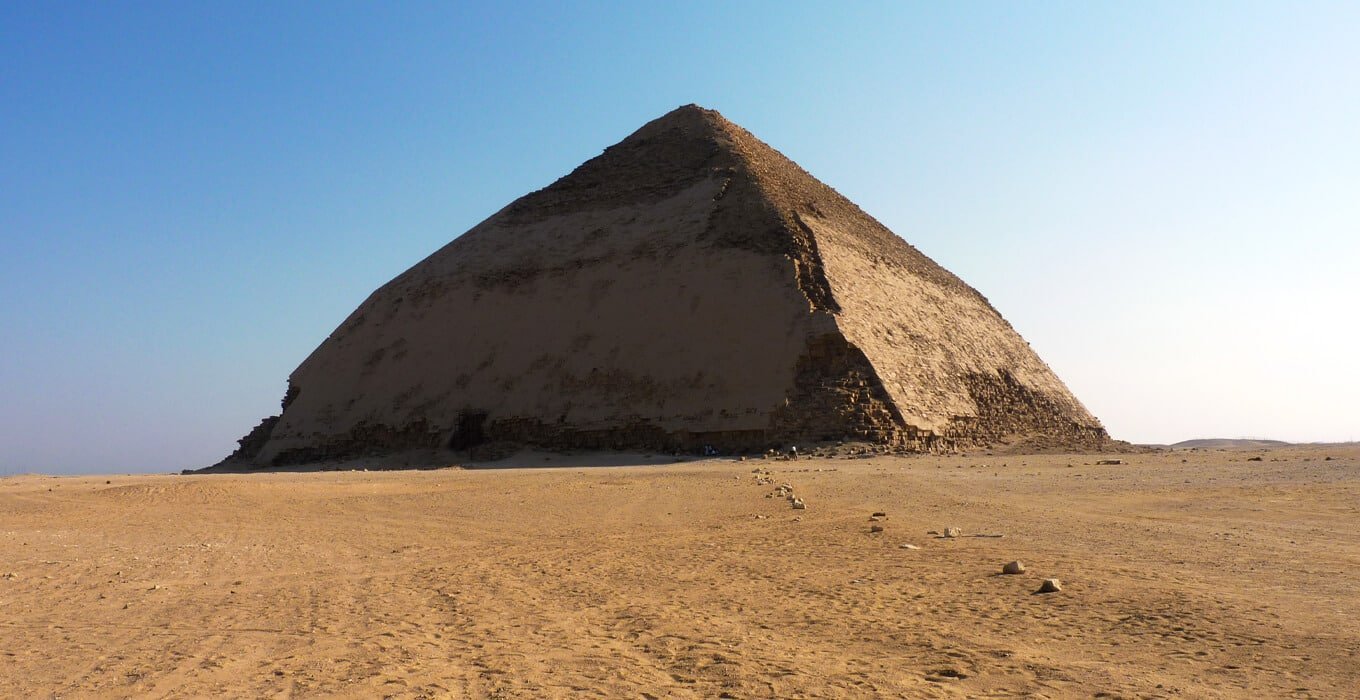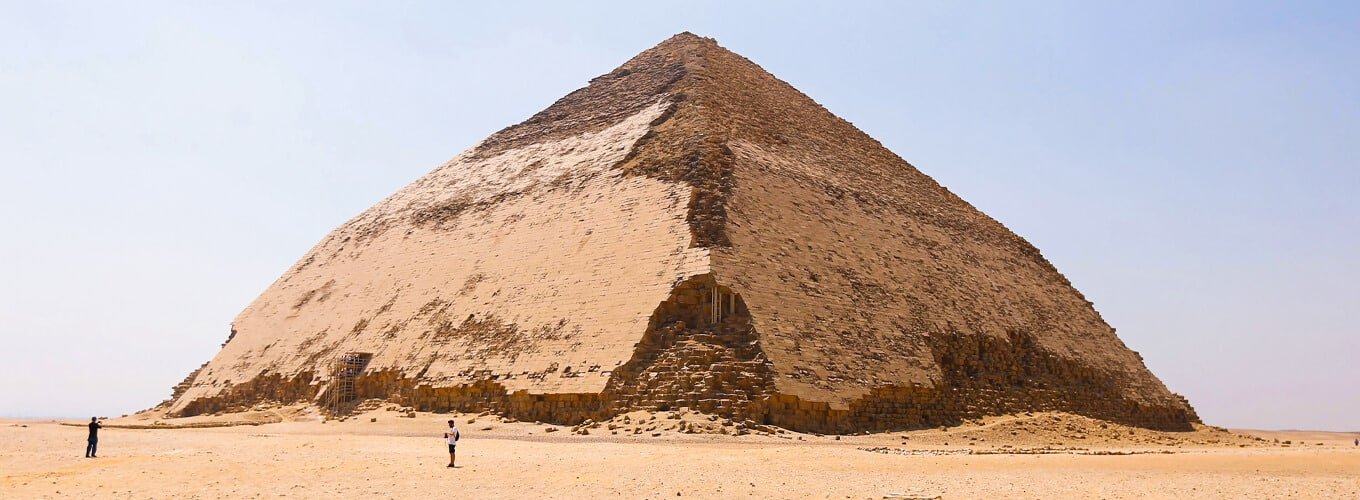The Pyramids of Dahshur offer a glimpse into the remarkable architectural evolution of ancient Egypt, showcasing the ingenuity and ambition of pharaohs during the Old and Middle Kingdoms. Unlike the bustling crowds of Giza, Dahshur provides a more intimate and serene experience, allowing visitors to marvel at the grandeur of these ancient structures without the distraction of large tour groups. These pyramids, along with other significant structures in the area, form a UNESCO World Heritage Site, recognizing their immense historical and cultural value.
The Bent Pyramid: A Unique Architectural Enigma
Among the pyramids of Egypt, the Bent Pyramid of Dahshur stands out with its peculiar shape. This enigmatic structure begins with a steep angle of 54 degrees, but abruptly shifts to a shallower 43-degree angle about halfway up. This unusual profile makes it one of the most visually striking and intriguing pyramids in the world.
There are several theories about why the Bent Pyramid was built this way. Some experts believe that during construction, structural instability became apparent, possibly due to the soft ground on which the pyramid was built. To prevent collapse, the builders may have been forced to reduce the angle, resulting in the ‘bent’ appearance.
Others theorize that the change in angle was intentional. Perhaps it was symbolic, representing a pharaoh’s changing relationship with the gods or a shift in religious beliefs. It’s also possible that the pharaoh Sneferu, who commissioned the pyramid, simply desired a faster completion time, and changing the angle was a means to expedite the process.
Regardless of the reason, the Bent Pyramid’s unique shape highlights the experimentation and innovation that characterized early pyramid construction in Egypt. It’s a testament to the ancient engineers’ ingenuity and their ability to adapt to challenges presented by these monumental projects.
The Red Pyramid: Sneferu’s Triumph

The Red Pyramid, also located at Dahshur, marks a significant milestone in ancient Egyptian architecture – it stands as the first true, smooth-sided pyramid ever constructed. This majestic structure, named for its reddish limestone casing, represents the culmination of the lessons learned from the Bent Pyramid. Pharaoh Sneferu, having potentially faced challenges with the Bent Pyramid, seems to have perfected the art of pyramid building with the Red Pyramid.
Visitors to the Red Pyramid have the unique opportunity to explore its internal chambers. A long, descending passage leads to several burial chambers, providing a fascinating glimpse into the pyramid’s design and intended purpose. While the climb is somewhat challenging, the experience of standing within these ancient spaces is unforgettable.
The Red Pyramid represents more than just an aesthetic achievement. It also showcases architectural innovations that would lay the foundation for future pyramids, including the Great Pyramid of Giza. The refined internal corbelling technique, used to distribute the weight of the structure, demonstrates the increasing sophistication of Egyptian engineering.
Other Notable Pyramids in Dahshur
While the Bent and Red Pyramids are the stars of Dahshur, the necropolis is home to several other pyramids that offer valuable insights into ancient Egyptian history.
- Pyramid of Amenemhat III: This pyramid, also known as the Black Pyramid, initially sported a beautiful casing of polished black granite. Unfortunately, it has suffered considerable deterioration over time, and much of its original grandeur is lost. Nonetheless, it holds historical importance as it illustrates the ongoing efforts of Middle Kingdom pharaohs to build monumental tombs.
- Pyramid of Senusret III: The Pyramid of Senusret III stands within the royal complex at Dahshur. While smaller in scale than the Bent or Red Pyramids, it presents a unique feature – elaborate subterranean apartments for female members of the royal family. Its intricate network of chambers highlights the complex funerary practices of the Middle Kingdom period.
These additional pyramids, despite their varying states of preservation, contribute to the overall understanding of Dahshur as a significant royal burial ground. They illustrate the continued experimentation with pyramid construction techniques and changing approaches to funerary architecture throughout different periods of Egyptian history.
Getting to Dahshur
Located approximately 40 kilometers south of Cairo, Dahshur is easily accessible for a day trip from the city. Here are several convenient transportation options:
- Tours: Numerous tour operators offer guided tours to Dahshur, often combined with visits to nearby sites like Memphis and Saqqara. This is a hassle-free option, as transportation, entrance fees, and knowledgeable guides are included in the tour package.
- Private Taxis: Hiring a private taxi from Cairo provides flexibility and allows you to set your own pace. Negotiate the price with your driver beforehand, and keep in mind that the return trip should also be included in the total cost.
- Public Transportation (for the adventurous): It’s possible to reach Dahshur using a combination of public buses and microbuses. However, this option is typically more time-consuming and requires navigating local transportation systems, making it less ideal for most tourists.
Distance and Travel Time
Depending on traffic, the journey from Cairo to Dahshur usually takes about 1-1.5 hours by car.
Tips for Visiting
- Opening Hours: The Dahshur site is generally open from 8 AM to 5 PM.
- Avoiding Crowds: To enjoy a less crowded experience, plan your visit for weekdays or early mornings.
- Sunscreen and Water: Bring sunscreen and a hat for protection against the strong Egyptian sun, and carry plenty of water to stay hydrated.
Experiencing the Best of Dahshur
To make the most of your time at Dahshur, consider these ways to immerse yourself in the experience:
- Enter the Pyramids: Unlike the Great Pyramids of Giza, visitors can enter the Red Pyramid and sometimes even the Bent Pyramid (check for availability, as it might occasionally be closed). Descending into these ancient chambers provides a thrilling and unforgettable perspective.
- Climb…Cautiously: Climbing to the top of the pyramids is generally not permitted at Dahshur to help preserve these structures. However, you may be able to ascend a short distance on designated areas for breathtaking views. Be sure to follow any posted regulations or guidelines.
- Explore Beyond the Pyramids: The Dahshur necropolis includes ruins of smaller pyramids, mastaba tombs, and other structures worth exploring. These often-overlooked sites provide additional context about the site’s historical importance.
- Nearby Attractions: Consider combining your Dahshur trip with a visit to the fascinating open-air museum of Memphis, the ancient capital of Egypt, or the Saqqara necropolis, home to the Step Pyramid of Djoser and other remarkable tombs.

Accommodations
While there are limited accommodation options directly in Dahshur, many visitors choose to stay in Cairo and make Dahshur a day trip. However, for those seeking a more extended stay near the pyramids, there are a few hotels and guesthouses in the nearby town of Saqqara.
FAQs
Is it safe to visit the Pyramids of Dahshur?
Egypt generally has a good safety record for tourists, and Dahshur is considered a safe place to visit. As with any travel, it’s wise to stay informed about current conditions and take common-sense precautions. Hiring a reputable tour guide or arranging transportation through a reliable company can enhance your peace of mind.
Can I go inside the Pyramids of Dahshur?
Yes! The Red Pyramid is typically open to visitors. The Bent Pyramid may sometimes be closed, so it’s best to check its accessibility beforehand. Remember that entering these pyramids involves descending narrow passages and may not be suitable for those with claustrophobia, mobility issues, or health concerns.
What is the best time of year to visit Dahshur?
To avoid extreme temperatures, the cooler months from October to April are the most pleasant for visiting Dahshur. Spring (March-April) and fall (October-November) offer especially comfortable weather conditions.
Are there any guided tours to Dahshur?
Yes, there are many reputable tour operators offering guided tours to Dahshur. These tours are often combined with visits to Saqqara, Memphis, or even Giza, providing a comprehensive overview of ancient Egyptian sites. Consider booking a tour for a convenient, informative, and hassle-free experience.
Conclusion
The Pyramids of Dahshur offer a unique and captivating glimpse into Egypt’s rich history and architectural evolution. Far from the bustling crowds of Giza, they provide a haven for those seeking a more intimate and serene experience of these ancient wonders. From the distinctive shape of the Bent Pyramid to the triumph of the Red Pyramid, Dahshur showcases the ambition and ingenuity of the Old and Middle Kingdom pharaohs.
If you long to explore the hidden gems of Ancient Egypt, a journey to Dahshur is an absolute must. Walk amongst these remarkable structures, descend into their mysterious chambers, and witness the architectural triumphs that have endured for millennia.
Related Article to Read:







